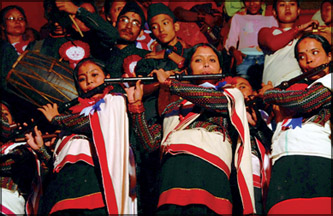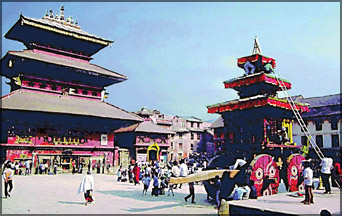The Kathmandu extravaganza
Lionel WIJESIRI
 |
|
Kumari is
prepared to be taken to the chariot |
Once a year in Nepal, both Hindus and Buddhists set aside their
religious differences to celebrate the joyous festival of Indra Jatra.
Dedicated to the Lord Indra, this festival is one of dancing, feasting
and rejoicing. In Nepal both Hindus and Buddhists abound and each
religious group generally has their own particular festivals which they
adhere to. However, during the celebration held to honour the rain god,
Lord Indra, both groups enjoy the many delights of life.
This year the festival was held from September 12 to 19 in Kathmandu.
Kathmandu, the Capital City of Nepal, has a very ancient history of
its origin. The history of Kathmandu dates back to 726 AD with king
Gunkamadev who established and named the city Kaasth Mandap by coining
two words 'Kaastha' and 'Mandap''. The term 'Kaastha' meant 'wood' and
Mandap 'beautiful shade'. At that time the city was so full of wooden
buildings and temples that it looked like it had a 'beautiful wooden
cover'. After many centuries the name changed and the new word Kathmandu
became the name by which the city was known in the local language.
Origin of festival
 |
|
Girls from
Sakya clan performing traditional flute music |
 |
|
Bhairav
which is uncovered only when the festival is on |
 |
|
Palace of
the the Living goddess - Kumari |
The origin of this festival is based on a story regarding Indra
Jatra's capture as a child when he has come down to Earth and was
picking a particular flower for his mother who wanted it to be used in a
special celebration. Unfortunately, during the act of picking the
flower, Indra Jatra was caught, accused of stealing and imprisoned. The
situation made it necessary for his mother to request Indra Jatra's
captors for her son's release. The captors were very happy to release
Indra Jatra once his mother had revealed his identity. As a gesture of
gratitude for Indra Jatra's release, his mother made a commitment to the
Nepalese to arrange for regular rains throughout the year.
Feast
The festival of Indra Jatra continues for eight days with much
rejoicing, singing, dancing and feasting. People from all over Nepal
gather at the Hanuman Dhoka in Kathmandu. (Hanuman Dhoka is the former
Royal Palace of the Malla kings. It has ten courtyards. King Pratap
Malla enlarged the original building in the 17th century, adding many
more temples. The palace was last lived in by the royal family until
1886).
On the first day, a long wooden pole is erected in front of the
ancient Royal Palace at Hanuman Dhoka, as a symbol to make peace with
Lord Indra. Classical dancers also assemble at the spot, wearing
different kinds of traditional masks and costumes and begin dancing
around the courtyards.
On the third day of the festival, the Living Goddess in all her
jeweled splendour travels through the older part of Kathmandu city in a
three tiered chariot accompanied by Ganesh and Bhairav. This event
continues for three days. It is really a grand gala in which people in
their thousands throng in and around the Kathmandu Durbar Square to pay
their homage to the Living Goddess. According to Hindu beliefs Ganesha
is the son of Shiva and Parvati, and Bhairav is another form of Lord
Shiva himself.
The festival's many interesting dances, including the Procession of
Living Goddess-Mahakali, Mahalaxmi and Dasha Avatara masked dances are
staged in Kathmandu Durbar Square. The excitement of the festival of
Indra Jatra comes to an end on the last evening of the festival when the
long wooden pole erected on the first day is lowered with religious
ceremonies.
Living Goddess
The selection of the Living Goddess is a highly elaborate tantric
ritual. The preliminary test is concerned with 32 attributes of
perfection, including the colour of her eyes, the shape of her teeth and
the sound of her voice. Her horoscope must also be appropriate.
The 4 to 7 year girls from the Sakya community are chosen and made to
confront a goddess in the darkened room. The sight of the Buffalo heads
scattered around, the demon-like masked dancers, the terrifying noises
they encounter scare some of these innocent girls.
The real goddess is unlikely to be frightened, so the one who is calm
and collected throughout the tests is the only girl who is entitled to
sit on the pedestal for worship as the Living Goddess. Then as a final
test similar to that of the Dalai Lama, the Kumari then chooses items of
clothing and decoration worn by her predecessor.
The god-house Kumari Ghar is a store-house of magnificent intricate
carvings where the Living Goddess performs her daily rituals.
During her tenure in the god-house, the Government Trust Fund bears
her entire expenses including that of her caretakers. Under normal
circumstances, her days in the god-house come to an end with her first
menstruation, but if she turns out to be unlucky, as they say, even a
minor scratch on her body that bleeds can make her invalid for worship.
She then changes back to the status of normal mortal and the search of a
new Kumari begins.
During Indra Jatra, there are a variety of performances including the
dances of Sawa Bhakku Bhairav from Halchowk, Lakhes from Majipat, Devi
Nach and Yeravat hathi (Pulukisi) from Naradevi, Mahakali and Kathi Maka
Nach from Bhaktapur. All the dances take place around Hanuman Dhoka
area. The Dasavatar or the ten incarnations of Lord Vishnu is also
staged every night.
Kumari Puja
There are several legends circulating about how the current sect of
the Kumari began. Most of the legends, however, lead back to King
Jayaprakash Malla, the last Nepalese king of the Malla Dynasty
(12th-17th century CE). According to the popular legend, a red serpent
approached the king's chambers late one night as he played tripasa, a
dice game, with the goddess Taleju.
Thereafter the goddess came along every night to play the game, but
only in a condition that the king would tell none about her.
The king's wife had suspicions and one day followed him. That night,
the king's wife and the Teleju saw each other. The goddess got angry and
told the king that if he ever wanted to see her again and protect the
country she would take the incarnation in a little girl of sakya
community. Hoping to make amends with his patroness, King Jayaprakash
Malla left the palace in search of the young girl who was possessed by
Taleju's spirit.
A variation of this and other legends names King Gunkam Dev, a 12th
century ancestor of King Jayaprakash Malla as the main character rather
than Jayaprakash Malla.
A third variation of the legend says that during the reign of King
Jayaprakash Malla, a young girl was banished from the city because it
was feared that she was possessed by the goddess Durga.
When the queen learned of the young girl's fate, she became enraged
and insisted that the king fetch the girl and appoint her as the living
incarnation of Durga.
Since Indra Jatra is a festival of classical dances, spectators can
enjoy a huge display of colour, movement and classical music exclusive
to Nepalese culture.
Even if the myths and tales wrapped up in the eight-day celebration
are not acceptable to you, the beautiful displays in and around Durbar
Square are entrancing enough for you visit Kathmandu in September next
year. |

